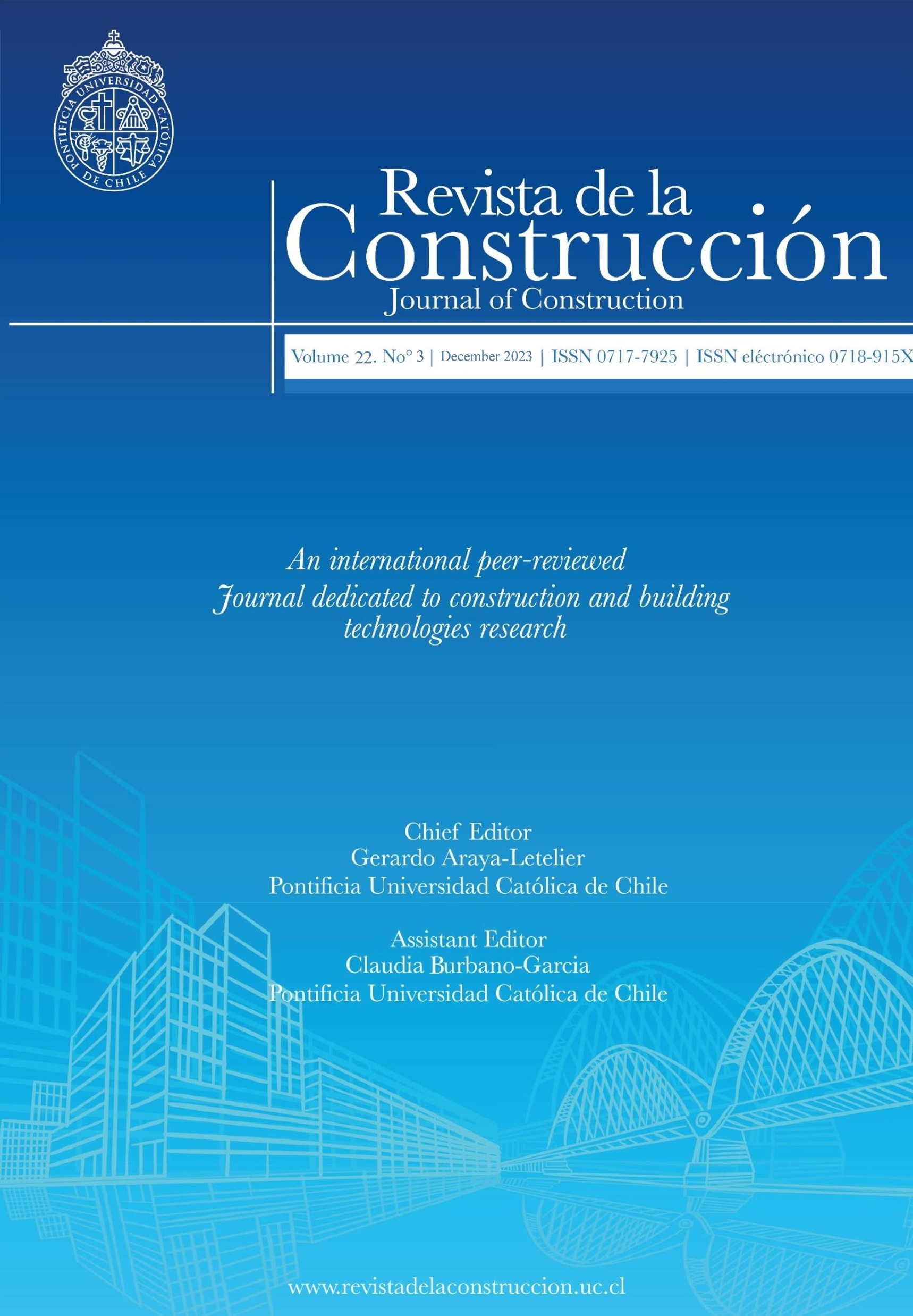Evaluation of the uses of treated sawdust as a partial replacement for aggregate in hot mix asphalt
DOI:
https://doi.org/10.7764/RDLC.22.3.553Keywords:
sawdust, Marshall test, full factorial DOE, mixing time, mixing temperature.Abstract
Undoubtedly, the damage to the upper layer of the road pavement caused by a tremendous load of vehicles and climate factors is an alarming and challenging fact to both government and researchers in the respective field. Thus, and with the aim to come up with a remedy, the potential of sawdust, as a renewable material for replacing aggregate in hot-mix asphalt, was examined. Therefore, a full factorial design of experiment (DOE) was conducted to evaluate the effects of sawdust content (5%, 10%, and 15% of total aggregate volume) on Marshall stability flow values and density. The range of binder from (5.77% to 6.45% means from low level to high level) and the temperature of mixing (140°C to 180°C) and the time of mixing (2 minutes to 4 minutes) as well. Also, to improve its durability, the sawdust was treated with an established emulsion coating. Accordingly, it has been demonstrated in this study that sawdust can be utilized as a partial replacement for (3/8) aggregate. Indeed, the use of this renewable material resulted in an increase in Marshall stability, a decrease in density, and flow values within the accepted range, leading to a positive environmental impact. Additionally, sawdust is considered a waste material, making it cost-effective. Ultimately, the acceptance criterion allows for the replacement of up to 7% of the aggregate for both low and high-level values; however, if more than 7% is replaced, only the highest-level value is considered acceptable. Thus, an economically and technically efficient solution may have been provided by this study.
Downloads
References
Hamid, B., Vahid, NMG. , Reza, S., Daniel, S. (2020). Evaluation of Fatigue and Rutting Behaviour of Hot Mix Asphalt Containing Rock Wool. Interna-tional Journal of Civil Engineering. https://doi.org/10.1007/s40999-020-00532-5
Mohammed, QI. , Mohammed, YF. , Abbas, FJ. (2021). Improving the rutting resistance of asphalt pavement modified with the carbon nanotubes addi-tive. Ain Shams Engineering Journal .Volume 12 (2021) 3619–3627. https://doi.org/10.1016/j.asej.2021.02.038
Mustafa, YA.,Sebnem, K., Mahmoud, E.(2021). Study on the effects of nano Sb2O3 on early and long-term aging behaviour of bitumen and asphalt mixtures. Ain Shams Engineering Journal .Volume 12 (2021) 3531–3542. https://doi.org/10.1016/j.asej.2021.02.041
Valerio, C., Jorge, R.T., Miguel, A., Jorge, R.H. (2018). EXPLORATORY STUDY OF POROUS ASPHALT MIXTURES WITH ADDITIONS OF RE-CLAIMED TETRA PAK MATERIAL. Construction and Building Materials. Volume 160. Pages 233-239. DOI:10.1016/j.conbuildmat.2017.11.067
Muhammad, BK., Nadeem, AQ., Arshad, H., Muhammad, JI. (2019). Enhancement of Hot Mix Asphalt (HMA) Properties Using Waste Polymers. Arabi-an Journal for Science and Engineering. https://doi.org/10.1007/s13369-019-03748-3
Nuha, SM., Amin, C., Hamid, N., Alireza, R. (2021). Investigating the engineering properties of asphalt binder modified with waste plastic polymer. Ain Shams Engineering Journal .Volume 12(2021) 1569–1574. https://doi.org/10.1016/j.asej.2020.08.035
Akpolat, M. (2022). Investigation of rutting, fatigue and cracking resistance parameters of CR modified warm
asphalt binders compare with SBS modified binders. Revista de la Construcción. Journal of Construction, 21(2), 309-328.
https://doi.org/10.7764/RDLC.21.2.309.
Laiana, F., Lêda, C., Adriano, E., Ablenya, G.(2019). Use of Banana Fibers in SMA Mixtures, Journal of Materials in Civil Engineering. 32(1), 04019341-1-04019341-10 page DOI:10.1061/(ASCE)MT.1943-5533.0002994.
Osuya, D., Mohammed, H.(2017). EVALUATION OF SAWDUST ASH AS A PARTIAL REPLACEMENT FOR MINERAL FILLER IN ASPHALTIC CONCRETE. Ife Journal of Science. vol. 19, no. 2. https://dx.doi.org/10.4314/ijs.v19i2.23
Ali, R.A., Gholam, H.H., Hossein, F. A.(2018). Providing Laboratory Rutting Models for Modified Asphalt Mixes with Different Waste Materials. Periodi-caPolytechnica Civil Engineering, 62(2), pp. 308–317. https://doi.org/10.3311/PPci.10684
Rajan, C., Abhinay, K., Kishori, M. (2018). Properties ofWaste Polyethylene Terephthalate (PET) Modified Asphalt Mixes: Dependence on PET Size, PET Content, and Mixing Process. PeriodicaPolytechnica Civil Engineering. paper10797. https://doi.org/10.3311/PPci.10797
Cetin, A., and Oral, G. (2022). Performance evaluation of porous asphalt mixtures modified with basalt fiber. Revista de la Construcción. Journal of Construction, 21(1), 93-104. https://doi.org/10.7764/RDLC.21.1.93.
Sandra, O., José, L., Jesner, S. (2012). Analysis of use of natural fibers and asphalt rubber binder in discontinuous asphalt mixtures, Construction and Building Materials, 26 13–20p. doi:10.1016/j.conbuildmat.2011.06.030
Tomas, U., Ganiron, J. (2014). Effect of Sawdust as Fine Aggregate in Concrete Mixture for Building Construction. International Journal of Advanced Science and Technology. Vol.63, pp.73-82. http://dx.doi.org/10.14257/ijast.2014.63.07
ZIDOUK, A.(2019).ÉTUDE DE L’INFLUNCE DE L’AJOUT DES FIBRES DU PALMIER DATTIER SUR LE MODULE DES ENROBÉS BITUMINEUX. Thesis Presented for obtaining the diploma of ACADEMIC MASTER.KASDI MERBAH OUARGLA UNIVERSITY.
Saswat, B.D., Mahabir, P.(2016) A Study on Use of Natural Fiber for Improvement in Engineering Properties of Dense Graded Bituminous Mixes with Coal Ash. Transportation in developing economies.2:4. DOI 10.1007/s40890-015-0008-z
Martina, M., Norman, H.S., Dieter, S.(2010) Physical properties of burnt timber with special focus on the drying performance. european journal of wood and wood products. DOI 10.1007/s00107-009-0388-z
Abderrezak, B., Salah, A., Fabrizo, S.(2015). Statistical analysis and effect of chemical treatment on the physic mechanical behavior of fibers from date-palm fruit branches. Synthèse Revue des Sciences et de la Technologie, Rev. Sci. Technol, Synthèse, 31: 108 -120.
Mojtaba, K., Alireza, A., Ali K. (2021).Influence of Polymeric Coating the Aggregate Surface on Moisture Damage of Hot Mix Asphalt. Periodi-caPolytechnica Civil Engineering, 65(2), pp. 376–384. https://doi.org/10.3311/PPci.14340
Bordjiba, A., Hacen, C.A., Guenfoud, H., Guenfoud, M. (2016). INFLUENCE OF RECYCLED AGGREGATES ON THE RESISTANCE OF BITUMI-NOUS CONCRETE IN THE PRESENCE OF ADDITIVES. Romanian Journal of Materials, 46 (1), 89 – 94.
BARBUȚĂ, M., MIHAI, P., PRECUL, A., BEJAN, L., ȚĂRANU, N., BANU, O. (2022). CONCRETE HOLLOW BLOCKS WITH WASTE MATERIALS REPLACING THE NATURAL AGGREGATES. Romanian Journal of Materials. 52 (1), 83-89
Rosa, H.R., Anadelys, A.A., Nelson, V.M. (2018). Evaluation of natural additives for warm asphalt mix. Revista de la Construcción. 1071. DOI:10.7764/RDLC.17.2.330
Jairo, FRL., Hugo, ARQ. , Saieth, BCP.(2019). Behavior of a Warm Mix Asphalt Containing a Blast Furnace Slag. International Journal of Civil Engineer-ing. https://doi.org/10.1007/s40999-019-00475-6
Van, BL., Van, PL. (2021). Performance Evaluation of Carbon Nanotubes as a Binder Modifier for Asphalt Mixtures. International Journal of Civil Engineering. https://doi.org/10.1007/s40999-020-00599-0
Downloads
Published
How to Cite
Issue
Section
License
Copyright (c) 2023 Mohamed Lakhder Guesmi, Zahreddine Nafa, Abdelhak Bordjiba

This work is licensed under a Creative Commons Attribution-NonCommercial-NoDerivatives 4.0 International License.








